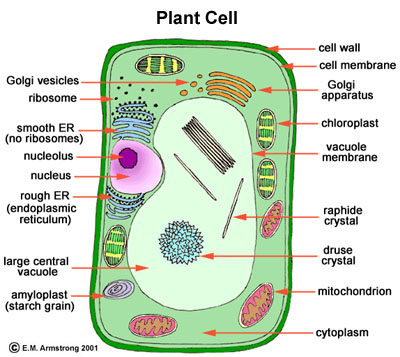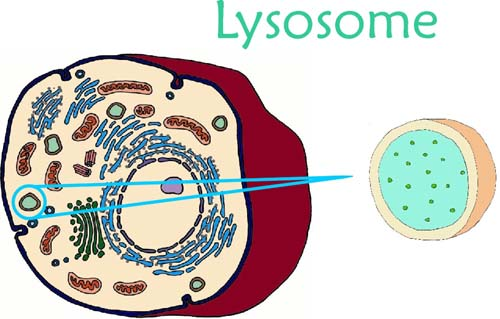LIFE .... as it begins
CELL- as a structural and functional unit
- Life began with a single unit of cell and is known as the structural and functional unit of body .
- A cell is a structure which is highly microscopic and cannot be visualized by naked eyes.
- Therefore, the microscopic structure of cell shows the presence of a membrane or a sturdy outer layer known as cell membrane in case of animal cell and in case of plant cell this cell membrane is enclosed by a flexible and sturdy structure known as the cell wall.
- The ground substance of the cell or the cell matrix is known as cytoplasm. The cytoplasm consists of many cell organelles, which play a major role in the biological system of organisms.
- The organelles are namely as follows:
- Nucleus
- Endoplasmic reticulum
- Golgi complex
- Mitochondria
- Plastids
- vacuoles
- Ribosomes
- Lysosomes
- Peroxisomes
- Centrosome
 |
| Structure of plant cell |
 |
| Structure of animal cell |
NUCLEUS
| Structure of nucleus |
The nucleus consists of a central nucleolus which is present in the nuclear matrix known as the Nucleoplasm, which thus forms the ground substance of the nucleus.
Nucleus is known as the master of the cell as it contains the genetic material in the form of DNA.
DNA is deoxyribonucleicacid which consists of genes. These genes form the unit of heredity that gets passed on from one generation to another .
ENDOPLASMIC RETICULUM

Endoplasmic reticulum is a continuation of the nuclear envelope and occurs in both plants and animals.
There are two types of endoplasmic reticulum namely, the rough endoplasmic reticulum and the smooth endoplasmic reticulum .
The rough endoplasmic reticulum is a continuation of the nuclear envelope and is known as rough due to the presence of ribosomes .
The smooth endoplasmic reticulum is devoid of ribosomes hence, so named .
The rough endoplasmic reticulum is responsible for protein synthesis and the smooth endoplasmic reticulum(SER) is responsible for synthesis of lipids and steroid hormones .
The SER also plays an important role in the detoxification , hence their number is much more in the liver than any other organ of the body.
The number of SER is great even in muscles as it functions for the transport of calcium from muscles to blood .
GOLGI COMPLEX
 |
| Stucture of golgi complex
Golgi complex is an organelle that is located very close to the endoplasmic reticulum and so to the nucleus.
It cosists of a stack of sacs known as cisternae and spherical shaped vesicles.
The golgi comples has two faces; cis and trans face .
The cis golgi faces towards the nucleus and the trans golgi faces away from the nucleus.
The golgi complex is responsible for packaging of proteins in the form of vesicles and then transporting them to their target.
MITOCHONDRIA
|
 |
| structure of mitochondria |
Mitochondria is a double membrane structure consisting of an outer continuous and inner discontinuous membrane
The inner membrane is thrown in the form of folds which give rise to finger like projections and are thus, known as crystae.
The space in between the outer membrane and inner membrane of the mitochondria is known as intermembranal space.
The mitochondrial matrix consists of glycogen granules in case of animals and starch granules in case of plants.
The crystae shows the presence of racket like structures, which are called as F1 particles and are responsible for synthesis of ATP molecules.
Mitochondria is also known as the power house of the cell because it provides energy to the cell in the form of ATP , which is required to perform many physiological functions of the biological system.
PLASTIDS
It is a double membrane organelle found among others, in the cells of plants and algae.
Plastids are the site of manufacture and storage of important compounds used by the cell.
They often contain pigments used in photosynthesis and the types of pigments present can change or determine the cell's color.
In plants, plastids may differentiate into several forms, depending upon which function they play in the cell.
They are differentiated into:
- Chloroplast - Green plastids for photosynthesis

- Chromoplast - coliured pigment for pigment synthesis
- Gerontoplast- control the dismantling of the photosyntLhetic apparatus and senescence
- Leucoplast - colourless plastid
- Amyloplasts - starch storage
- Elaioplasts - Fat storage
- Proteinoplasts- Protein storage
- Tannosomes - synthesizing and producing tannins and polyphenols
Ribosomes

Ribosomes are the protein builders or protein synthesizers of the cell.
Ribosomes are found in many places.
They are found floating freely in the cytosol.
Other ribosomes are found on the endoplasmic reticulum.
LYSOSOMES

Lysosomes are a membrane bound cell organelle found in most animal cells.
Lysosomes contain hydrolytic enzymes capable of breaking down virtually all kinds of biomolecules, including proteins, nucleic acids, carbohydrates, lipds and cellular debris.
Enzymes which are present in lysosomes are active at acidic pH, hence they are known as acid hydrolases.
They are also called as suicidal bags as they have the capability to digest any type of biomolecule.
CENTROSOMES

Centrosomes are organelles that are membrane bound
It helps in organizing microtubules to be utilized during cell division.
Centrosomes consists of two centrioles that are held perpendicular to each other.
* Do put your suggestions below *

This comment has been removed by a blog administrator.
ReplyDeleteGood work......
ReplyDeleteKeep going on 👍👍👍
thnks vahini
DeleteThis comment has been removed by the author.
ReplyDelete